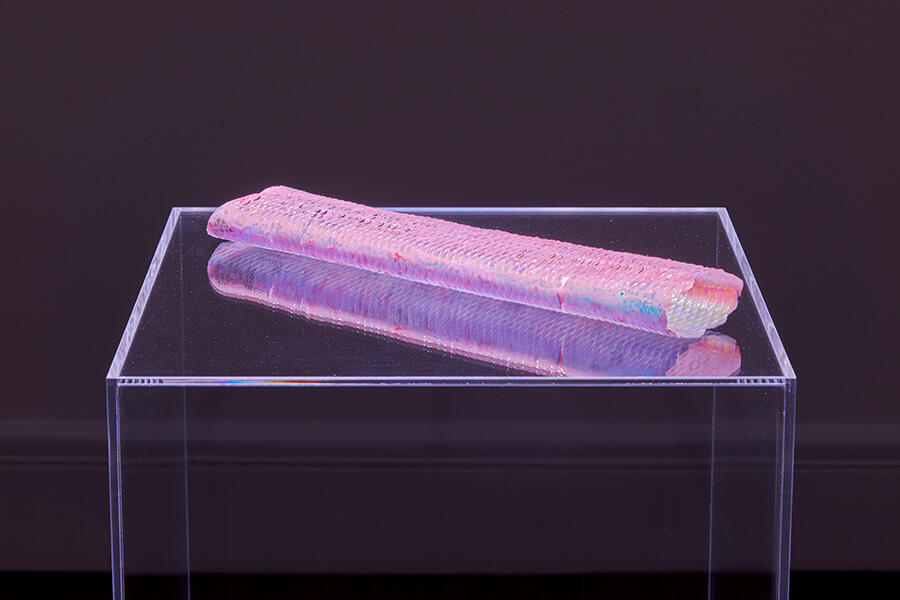Pamela Rosenkranz Searches for Ancient Wisdom in Modern Technology
At Sprüth Magers in London, the artist’s robotic snake is a harbinger of destruction and regeneration
At Sprüth Magers in London, the artist’s robotic snake is a harbinger of destruction and regeneration

There is a serpent loose in Pamela Rosenkranz’s solo show, ‘Healer’, at Sprüth Magers. The product not of sticky biology, but of a pristine robotics lab, this work – titled Healer (Anamazon) (all works 2021) – comprises 1.3 metres of servo motors, sensors and semiconductors, sheathed in a reflective 3D-printed skin, into which scales have been incised using a technique borrowed from the Japanese craft of kirigami (paper cutting). When I first glimpsed the Swiss artist’s snake-bot through the gallery’s picture window, shimmering beneath a bank of jungle-green ceiling lamps, it was lying motionless on the floor, as though it were the inhabitant of a reptile house, conserving energy until an obliging zookeeper tipped some small, scrabbling rodent into its tank. It was several minutes after I stepped inside the exhibition space that the ‘creature’ finally stirred, its metal vertebrae performing a sinuous sidewind, the LEDs of its eyes blinking and fixing me with a pitiless red stare.

Just as changing meteorological conditions affect the quality of the light that falls through Sprüth Magers’ windows onto the snake-bot’s scales, so the algorithm that animates Healer (Anamazon) responds to an invisible and ever-fluctuating ‘weather system’ of electronic signals, created by the panoply of wired devices in the gallery building and visitors’ own mobile tech. What causes it to move, then, is not a rustle in the undergrowth, but the twitch of a security camera, the ping of an email, a Fitbit demanding its daily tribute of steps.
Yet, for all that the bot is a product of the digital age, it also speaks to deep cultural memory. Watching it twist and ripple, I got to thinking of the fatally seductive Biblical serpent, of the snake that coils around the staff of Asclepius, Greek god of medicine, of Norse mythology’s world-girdling Midgard Serpent and of the Ancient Egyptian ouroboros, a snake that consumes its own tail, symbolizing the endless cycle of life, death and rebirth. Research has shown that, over millennia, the human eye has become increasingly adept at recognizing serpentine movements. Snakes are not only a potential threat – or a potential meal – they have also functioned as catalysts of our evolutionary development.

At one moment during my visit, the bot raised its head and appeared to stare at itself in the surface of Anamazon (Shine Through), one of a series of works in which mirrors and sheets of aluminium have been treated with washes of roseate acrylic and painters’ medium – slicks of fluid redolent of blood thinned with other bodily secretions, perhaps generative semen, perhaps useless tears. Rosenkranz also applied this pink-tinged filter, in various concentrations, to large-scale watermarked stock photos of the (daily more imperilled) Amazon rainforest, such as Anamazon (Get Digit), and of the human eye, such as I Wish I Could Cry Blood (All Stars). Hung close to the ground, these ocular images seemed designed to be peered at not by a homo sapiens audience, but by the low-bellied robo-snake.
If ‘Healer’ is a show about convergence and divergence – of beings, of signals, of ways of seeing – it is also about entropy and, perhaps, the possibility of renewal. Displayed on a clear Perspex plinth, Healer Skins (Sunset Lodge) is a tubular length of PVC hide, shed by Rosenkranz’s serpent. Snakes have lived on Earth for some hundred million years, modern humans for a mere 300,000. How much longer will the two species cohabit, and which will survive the other? The bot writhes on the gallery floor. Watching it, we cannot know what hidden data guides its movements, or where it will turn next.
Pamela Rosenkranz’s solo exhibition ‘Healer’ is on view at Sprüth Magers, London, until 20 November.
Main image: Pamela Rosenkranz, 'Healer', 2021, exhibition view, Sprüth Magers, London
























